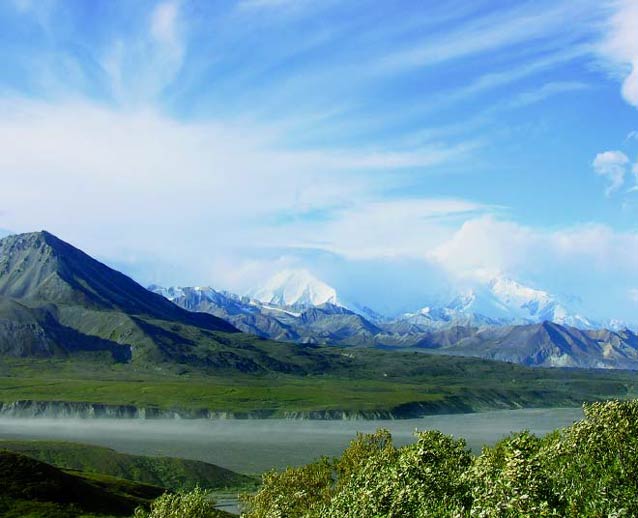With global pollution projected to increase over time, Denali’s clean air is dependent on international as well as national efforts to limit emission increases. As a prominent wilderness tourist destination, the park may help inspire global citizens to protect clean air partly because it is an integral part of Denali’s intact ecosystem.
As was expected, results from each monitoring network show that the air in Denali is exceptionally clean on most days. During summer, however, it is not unusual for naturally-occurring smoke from wildland fires to significantly decrease visibility.

NPS Photo / Kent Miller
Introduction
The Clean Air Act and the National Park Service Organic Act require park managers to protect air quality in Denali National Park and Preserve. So far, this has not been an unduly daunting task, since the air in Denali is among the cleanest in the country. When the first air quality monitoring instruments were installed in the park in 1980, it was assumed that the measurements in Denali would reveal a simple story, documenting background conditions similar to what might have existed in the contiguous 48 states before the industrial revolution. Instead, a second story emerged, hidden in the consistently low airborne contaminant measurements collected at the site. Emission sources far from the park influence the annual cycle of contaminant concentrations, and are linked to the park through intercontinental transport pathways.
In addition to directly measuring contaminant concentrations in air, snow and rain, the National Park Service also collects and makes available to the public real-time photographic visibility data. The Denali visibility web camera operates during the summer months, archiving high-resolution images of the Alaska Range vista. Lower-resolution images are posted to an educational NPS web page via satellite.
Methods
The National Park Service Air Resources Division operates a nationwide air quality monitoring network, comprised of several separate internal and interagency monitoring networks. They are, in order of installation in Denali: the National Atmospheric Deposition Network (NADP), the Interagency Monitoring of Protected Visual Environments Program (IMPROVE), the National Park Service Gaseous Pollutant Monitoring Network, and the Clean Air Status and Trends Network (CASTNet). The NADP program measures deposition of airborne contaminants in precipitation. The IMPROVE network samples fine particles and select gases that cause visibility impairment, by collecting samples on filters, and the CASTNet program uses filter samples to model deposition of airborne contaminants to ecosystems in the absence of precipitation. The NPS Gaseous Pollutant Monitoring Network continuously measures ground-level ozone in Denali, recording hourly values. The NPS also measures meteorological parameters that help interpret air quality data, such as wind speed and direction, temperature, and relative humidity. Each nationwide air quality monitoring network maintains a web site that provides an overview of sample design and methods, as well as public access to validated data. There are links to these sites on the NPS Air Resources Division web site at https://www2.nature.nps.gov/air/.

NPS Photo
Results
As was expected at the outset of monitoring, results from each monitoring network show that the air in Denali is exceptionally clean on most days. During summer, however, it is not unusual for naturally-occurring smoke from wildland fires to significantly decrease visibility throughout Interior Alaska, including Denali.
Concentrations of anthropogenic airborne contaminants, while low, show a strong seasonal trend, with peaks often occurring in the winter and early spring. This pattern is consistent with international transport of airborne contaminants to Alaska via transport pathways over the Arctic and Pacific Oceans (Wilcox 2001).
Discussion and Conclusions
Park managers can best prevent and mitigate human-caused ecosystem impairment within park boundaries. However, this does not mean that the agency’s influence stops at the borders of the park or even the country. In addition to conducting research and monitoring which supports the regulatory process, the NPS can help mitigate threats beyond park boundaries through education and inspiration. Some of the ways in which parks help inspire people to minimize collective human impacts:
- National parks inspire people to be concerned about issues beyond their own backyards.
- Park science and education programs help people better understand threats to park resources.
- People care about parks. International threats to national parks can motivate people to support international solutions to global problems.
- Parks are symbols of unimpaired wilderness. Contaminant threats to park ecosystems may inspire public concern at a lower threshold than threats to non-park lands.
- National parks can promote energy efficiency and sustainability to encourage people to reduce their impact on the global environment.
The Denali ecosystem is predominantly intact and pristine, compared to many protected areas outside Alaska. The park atmosphere is no exception. At present, the air in Denali is generally cleaner than in most parks and wilderness areas throughout the country. It is not, however, free from anthropogenic contaminants. In addition to local and regional sources, airborne contaminants from sources on other continents are currently transported into the park in small amounts on a predictable annual cycle. As global development continues to increase along with a growing human population, emissions from international source areas are likely to increase as well. If park air quality is to remain the spectacular natural resource it is today, efforts to limit emission increases will need to be global as well as national.
Acknowledgements
The Denali air quality monitoring program would not be possible without the support of numerous dedicated per-sonnel associated with the NPS Air Resources Division, the various nationwide air quality monitoring networks, and associated network contractors. Field staff include Pamela Sousanes, Nikki DeMers, Phil Brease, Chad Hults, and Guy Adema. Thanks are due to Christine Shaver for her vision and leadership of the NPS Air Resources Division.
References
National Park Service Air Resources Division. 2002.
Air Quality in the National Parks. Second Edition. Lakewood, Colorado.
Wilcox, Walter James II. 2001.
The origin and composition of aerosols in the Alaskan airshed. Master of Science Thesis. University of Alaska Fairbanks.
Part of a series of articles titled Alaska Park Science - Volume 6 Issue 2: Crossing Boundaries in a Changing Environment.
Last updated: February 2, 2015
